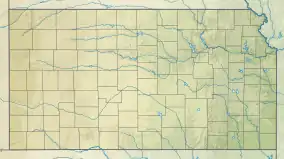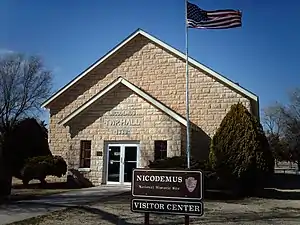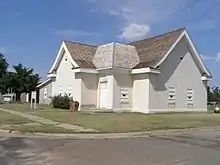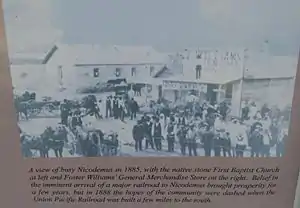Nicodemus National Historic Site
Nicodemus National Historic Site, located in Nicodemus, Kansas, United States, preserves, protects and interprets the only remaining western town established by African Americans during the Reconstruction Period following the American Civil War. The town of Nicodemus is symbolic of the pioneer spirit of African Americans who dared to leave the only region they had been familiar with to seek personal freedom and the opportunity to develop their talents and capabilities. The site was named, at least in part, for a legendary African-American slave featured in abolitionist Henry Clay Work's "Wake, Nicodemus (1864)." It is a mystical story of an old slave died away and buried in a hollow tree who had asked to be awakened on the Day of Jubilee.[1]
| Nicodemus National Historic Site | |
|---|---|
  | |
| Location | Nicodemus, Kansas, United States |
| Nearest city | Nicodemus, Kansas |
| Coordinates | 39°23′27″N 99°37′03″W |
| Area | 161 acres (65 ha) |
| Established | November 12, 1996 |
| Visitors | 28,065 (in 2005) |
| Governing body | National Park Service |
| Website | Nicodemus National Historic Site |

The historic site contains five buildings:
- Township Hall (now home to a temporary visitor center)
- African Methodist Episcopal Church
- First Baptist Church
- St. Francis Hotel
- Nicodemus School District #1 Schoolhouse
The story of Nicodemus
Nicodemus was founded in 1877, led by Rev. W.H. Smith, a black minister, and W.R. Hill, a white land developer, and five other black men who formed the Nicodemus Town Company and began visiting churches in Kentucky to encourage people to move to Kansas. Kansas was a free state, part of the Underground Railroad and home to abolitionist John Brown. Handbills and flyers distributed by the company called Nicodemus a place for "African Americans to establish a black self-government."
By the mid-1880s Nicodemus was a small, bustling town. There were two newspapers, three general stores and at least three churches. The town had a number of small hotels, an ice cream parlor, bank, livery and a number of homes. The population was an estimated 700 at the town's heyday.
To ensure growth the town needed the railroad. The residents of Nicodemus made several attempts to reach out to various railroad companies in an attempt to attract a rail line to Nicodemus, but it was all to no avail. The railroad passed to the south. Over time people moved closer to the railway and established a new town called Bogue. Bogue has a population of 173 today.
Perhaps one of Nicodemus' most famous residents is Veryl Switzer. Switzer was an All-American football player for Kansas State in 1951, 1952 and 1953. He went on to play two seasons for the National Football League Green Bay Packers, before taking leave to serve in the U.S. Air Force. He resumed his professional career with the Packers after 2½ years in the military. He later went on to play for the Calgary Stampeders and the Montreal Alouettes of the Canadian Football League before retiring.
Switzer is now farming 840 acres (3.4 km2), in Nicodemus, and is one of the top investors in the creation of a flour mill there. A co-op was formed in 1999; and, while "Promised Land Flour" and "Nicodemus Pancake Mix" are being marketed, the flour mill has not yet been built.
The site is still home to several descendants of the original settlers. It was designated a National Historic Site by an Act of Congress in 1996.
Sources: The Kansas Guidebook by Marci Penner, Copy. 2005 and The Associated Press
 St Francis Hotel
St Francis Hotel African Methodist Episcopal Church
African Methodist Episcopal Church Nicodemus Township School
Nicodemus Township School First Baptist Church
First Baptist Church Township Hall
Township Hall
Academic references
- Kansas State Historical Society, Historic Sites Survey. Historic Preservation in Kansas. Black History Sites, A Beginning Point. Topeka: Kansas State Historical Society, 1977.

Other sources
- The Kansas Guidebook for Explorers by Marci Penner, copyright 2005
- Associated Press report "Former football star returns to help save dying town," August, 2006.
References
- Rosamond, Rodman (2008). "Naming A Place Nicodemus". DigitalCommons@University of Nebraska - Lincoln. Great Plains Quarterly. Retrieved 31 Mar 2016.
External links
- National Park Service: official site
- Kansas State Historical Society Nicodemus Portrait
- Historic American Buildings Survey (HABS) No. KS-49, "Nicodemus Historic District, Nicodemus, Graham County, KS", 10 photos, 5 measured drawings, 3 data pages, 1 photo caption page
- HABS No. KS-49-A, "Carrie Dabney House, Hill City Township, Nicodemus, Graham County, KS", 6 photos, 1 photo caption page
- HABS No. KS-49-B, "Nicodemus Township Hall, Washington & Second Streets, Nicodemus, Graham County, KS", 6 photos, 3 data pages, 1 photo caption page
- HABS No. KS-49-C, "Fairview School, Second & Washington Streets (moved to), Nicodemus, Graham County, KS", 3 photos, 3 data pages, 1 photo caption page
- HABS No. KS-49-D, "Jerry Scruggs, Jr. House, Adams & Second Street, Nicodemus, Graham County, KS", 4 photos, 3 data pages, 1 photo caption page
- HABS No. KS-49-E, "Lloyd Wellington House, Adams & Second Streets (moved to), Nicodemus, Graham County, KS", 4 photos, 3 data pages, 1 photo caption page
- HABS No. KS-49-F, "Switzer Bunkhouse, Washington & Third Streets, Nicodemus, Graham County, KS", 4 photos, 1 photo caption page
- HABS No. KS-49-G, "Fletcher-Switzer House, Washington & Second Streets, Nicodemus, Graham County, KS", 5 photos, 9 measured drawings, 1 photo caption page
- HABS No. KS-49-H, "Joe Wilson's Post Office, South Avenue & Third Street (moved to), Nicodemus, Graham County, KS", 2 photos, 9 measured drawings, 3 data pages, 1 photo caption page
- HABS No. KS-49-I, "African Methodist Episcopal (AME) Church, Adams & Third Streets, Nicodemus, Graham County, KS", 6 photos, 7 data pages, 1 photo caption page
- HABS No. KS-49-J, "Ace Williams House, Fourth Street (moved to), Nicodemus, Graham County, KS", 2 photos, 3 data pages, 1 photo caption page
- HABS No. KS-49-K, "Old First Baptist Church, Fourth & Washington Streets, Nicodemus, Graham County, KS", 8 photos, 9 measured drawings, 7 data pages, 1 photo caption page
- HABS No. KS-49-L, "First Baptist Parsonage, Fourth & Washington Streets, Nicodemus, Graham County, KS", 5 photos, 3 data pages, 1 photo caption page
- HABS No. KS-49-M, "Charles Williams House, South Avenue & Fourth Street (moved to), Nicodemus, Graham County, KS", 4 photos, 3 data pages, 1 photo caption page
- HABS No. KS-49-N, "Dr. Stewart House, Washington Street, Nicodemus, Graham County, KS", 5 photos, 3 data pages, 1 photo caption page
- HABS No. KS-49-O, "District No. 1 School, Madison & Fourth Streets (moved to), Nicodemus, Graham County, KS", 6 photos, 3 measured drawings, 3 data pages, 1 photo caption page
- HABS No. KS-49-P, "Calvin Sayers House, Madison Street, Nicodemus, Graham County, KS", 7 photos, 3 data pages, 1 photo caption page
- HABS No. KS-49-Q, "Tim Lacey House, Block 35, Nicodemus, Graham County, KS", 3 photos, 3 data pages, 1 photo caption page
- HABS No. KS-49-R, "Clementine Vaughn House, Block 40, Nicodemus, Graham County, KS", 4 photos, 3 data pages, 1 photo caption page
- HABS No. KS-49-S, "Alexander G. Vanduvall House, Nicodemus, Graham County, KS", 4 photos, 1 photo caption page
- HABS No. KS-49-T, "Henry Williams House, Nicodemus, Graham County, KS", 8 photos, 1 photo caption page
- HABS No. KS-49-U, "Emma Williams House, Nicodemus, Graham County, KS", 2 photos, 1 photo caption page
- HABS No. KS-49-V, "Mount Olive Church, South Street, Nicodemus, Graham County, KS", 6 photos, 1 photo caption page
- HABS No. KS-49-W, "Mount Olive School, South Street, Nicodemus, Graham County, KS", 4 photos, 1 photo caption page
- HABS No. KS-49-X, "Jerry Scruggs House, Seventh Street, Nicodemus, Graham County, KS", 3 photos, 1 photo caption page
- HABS No. KS-49-Y, "John Edwards House, Nicodemus, Graham County, KS", 6 photos, 1 photo caption page
